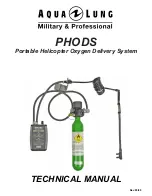
26
5.3 Two-Point Slope Calibration
We do not recommend 2-point slope field calibration for new sensor installations; for most if
not all applications the factory set slope will provide the best results.
The 2-point calibration should only be done when the sensor begins to lose response or
sensitivity. The 1-point offset is the only calibration required on a regular basis.
Performing calibration with fluoride standards will not get the inline installation dialed-in.
This can only be done with a proper grab sample offset calibration.
The 2-point calibration determines the sensitivity or slope of each sensor, which is then stored in the
analyzer.
The ‘hold’ feature is automatically activated each time any 2-point or 1-point calibration is performed.
This means that the last process value will continue to be sent via the analog 4-20mA and Modbus
digital output before entering the calibration mode. This is the default behavior and can only be
modified at the Foxcroft factory if this is not desired.
For a 2-point calibration you will need:
•
A clean sensor. Please refer to the cleaning procedure in the previous section.
•
A 250 ml glass or plastic beaker that is heavy enough to prevent the sensor from tipping the beaker over.
•
Low Fluoride Standard Solution (low ppm) mixed with TISAB II total ionic strength adjusting buffer
•
High Fluoride Standard Solution (high ppm) mixed with TISAB II total ionic strength adjusting buffer
NOTE:
The calibration solutions need to be at least 1 decade (10 times) apart.
Always use the more stable TISAB II rather than TISAB III total ionic strength adjusting
buffer for both self prepared and premixed solutions purchased from a lab supply
company.
Since the fluoride transmitter has a 3-digit display, a 1,000 mg/L (ppm) calibration solution
will only display as “999”. It’s suggested to use a “non-standard” solution of lower
concentration in order to display 3 significant digits during calibration.
If you wish to make your own calibration solutions instructions to do so are below.
NOTE:
If your system includes the FX-300-TOT module that provides a pH compensated total
unbound ion measurement, you must first ensure the temperature matches between the ISE, pH and
TOT modules, and you must also calibrate your pH sensor if needed. To enter the calibration value
use the keys on the ISE module until the display on the FX-300-TOT module displays the correct
reading.
5 Calibration
















































